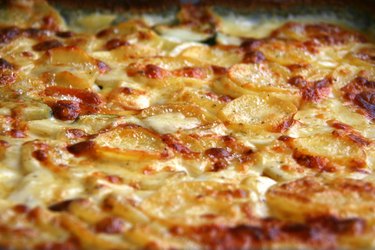
As comfort food goes, few combinations are as rich and satisfying as potatoes and cream. Many variations of that pairing are traditional favorites, from loaded baked potatoes to bowls of light, fluffy mashed. One of the richest and most compelling versions is gratin Dauphinois, the French version of scalloped potatoes. It's easy to prepare, and makes a glorious side dish or a simple meal in its own right.
No Prince Required
Video of the Day
There's a persistent story that gratin Dauphinois was created to tempt the picky-eater tastebuds of a crown prince -- in French, the Dauphin -- but that's unlikely. It's more reliably identified with the Dauphine region of France, a dairy-rich land of alpine meadows bordering on Switzerland. The French have a tradition of naming dishes after locations known for their main ingredient, such as "Argenteuil" for anything containing asparagus, or "Crecy" for carrot-based dishes. The same logic made the term "Dauphinois" an obvious identifier for a cream-drenched potato gratin.
Video of the Day
Compare and Contrast
There is no single canonical version of the gratin, which means there's no ready way to distinguish it from any other form of scalloped potatoes or potato gratin. Some authoritative sources, including the Larousse Gastronomique and the legendary chef Escoffier, call for eggs and Gruyere cheese in their versions. Others spurn both of those ingredients, relying on the potatoes' own starch for thickening and declaring the dish rich enough without cheese. You'll find recipes using just heavy cream, or a mixture of cream and milk. A few ingredients are less controversial. Most call for some form of onion, and for at least a hint of garlic in the potatoes. Classic recipes usually call for a hint of nutmeg as well, which somehow makes the cream taste creamier.
The Basic Method
You'll need a casserole or baking dish, rubbed with garlic and buttered liberally to minimize sticking. Slice your potatoes thinly -- depending on the size of the recipe, you'll need 1 to 3 pounds -- and layer them into the dish. Your recipe might call for you to mix the cream and other ingredients to make a sauce, and toss the potatoes in the sauce first. Some traditional recipes even suggest boiling the potatoes briefly in the sauce before transferring them to your baking dish. In any case, the potatoes should be arranged in flat layers in your dish and should be covered by the cream. Bake the gratin at 375 to 400 degrees Fahrenheit, for 45 minutes to an hour, until the potatoes are tender and it's bubbly and well-browned. Let it cool for at least 15 minutes before serving.
Pick a Potato
One of the major points of controversy for gratin Dauphinois lovers is the choice of potato. Some recipes recommend starchy russets or their European equivalents, which release copious quantities of starch to thicken the sauce. Others recommend waxy potatoes, such as Red Bliss, which hold their shape better throughout the prolonged cooking process. Yukon Golds are a fine compromise, a medium-starchy potato that thickens the sauce adequately, yet holds its shape well. Whichever potato you choose, it must be sliced thinly and evenly to ensure consistent cooking. If you own a mandoline slicer or a food processor with a slicing disc, this dish presents an ideal opportunity to make use of it.